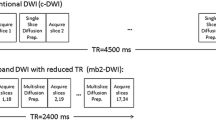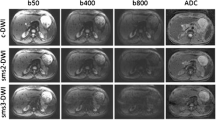Abstract
Objective
To evaluate simultaneous multislice (sms) accelerated diffusion-weighted imaging (DWI) of the liver in comparison to conventional sequences.
Materials and methods
Ten volunteers underwent DWI of the liver at 1.5 T. Four different sms-accelerated sequences with monopolar and bipolar gradient preparation (MP, BP) and acceleration factors 2 and 3 (sms2-DWI, sms3-DWI) were compared to conventional DWI (c-DWI). Image quality criteria rated on a 5-point Likert scale (5 = excellent), image quality sum scores (maximum 120), and ADC were compared using Friedman test and Dunn-Bonferroni post hoc test. Bland–Altman plots were calculated for ADC comparison. p values <0.05 were considered significant.
Results
Sms2-DWI offered scan time minimization of 67 % without significant difference in image quality (sum score: sms2-DWI MP/BP: 97 ± 8/92 ± 9; c-DWI MP/BP: 99 ± 8/97 ± 8). Sms3-DWI offered slight additional scan time minimization with significantly inferior image quality (sum score: sms3-DWI MP/BP: 75 ± 14/69 ± 14; p < 0.001). MP preparation provided slightly higher image quality in sms-DWI without statistical significance. ADC in sms-DWI were significantly lower (sms2-DWI MP 1.01 × 10−3 mm2/s; c-DWI MP 1.20 × 10−3 mm2/s; p < 0.001).
Conclusion
Sms2-DWI provides considerable scan time minimization without significant shortcomings in image quality. Sms3-DWI provides significantly inferior image quality without further scan time minimization. Potentially lower ADC in sms-DWI should be considered in clinical routine.







Similar content being viewed by others
References
Bharwani N, Koh DM (2013) Diffusion-weighted imaging of the liver: an update. Cancer Imaging 13:171–185
Taouli B, Koh DM (2010) Diffusion-weighted MR imaging of the liver. Radiology 254(1):47–66
Wagner M, Doblas S, Daire JL, Paradis V, Haddad N, Leitao H, Garteiser P, Vilgrain V, Sinkus R, Van Beers BE (2012) Diffusion-weighted MR imaging for the regional characterization of liver tumors. Radiology 264(2):464–472
Bains LJ, Zweifel M, Thoeny HC (2012) Therapy response with diffusion MRI: an update. Cancer Imaging 12:395–402
Filipe JP, Curvo-Semedo L, Casalta-Lopes J, Marques MC, Caseiro-Alves F (2013) Diffusion-weighted imaging of the liver: usefulness of ADC values in the differential diagnosis of focal lesions and effect of ROI methods on ADC measurements. Magn Reson Mater Phys 26(3):303–312
Feinberg DA, Moeller S, Smith SM, Auerbach E, Ramanna S, Gunther M, Glasser MF, Miller KL, Ugurbil K, Yacoub E (2010) Multiplexed echo planar imaging for sub-second whole brain FMRI and fast diffusion imaging. PLoS One 5(12):e15710
Lau AZ, Tunnicliffe EM, Frost R, Koopmans PJ, Tyler DJ, Robson MD (2015) Accelerated human cardiac diffusion tensor imaging using simultaneous multislice imaging. Magn Reson Med 73(3):995–1004
Obele CC, Glielmi C, Ream J, Doshi A, Campbell N, Zhang HC, Babb J, Bhat H, Chandarana H (2015) Simultaneous multislice accelerated free-breathing diffusion-weighted imaging of the liver at 3T. Abdom Imaging
Lewis S, Kamath A, Chatterji M, Patel A, Shyknevsky I, Dyvorne HA, Kuehn B, Taouli B (2015) Diffusion-weighted imaging of the liver in patients with chronic liver disease: comparison of monopolar and bipolar diffusion gradients for image quality and lesion detection. AJR 204(1):59–68
Kyriazi S, Blackledge M, Collins DJ, Desouza NM (2010) Optimising diffusion-weighted imaging in the abdomen and pelvis: comparison of image quality between monopolar and bipolar single-shot spin-echo echo-planar sequences. Eur Radiol 20(10):2422–2431
Shimizu H, Isoda H, Fujimoto K, Kawahara S, Furuta A, Shibata T, Togashi K (2013) Comparison of acquired diffusion weighted imaging and computed diffusion weighted imaging for detection of hepatic metastases. Eur J Radiol 82(3):453–458
Dyvorne HA, Galea N, Nevers T, Fiel MI, Carpenter D, Wong E, Orton M, de Oliveira A, Feiweier T, Vachon ML, Babb JS, Taouli B (2013) Diffusion-weighted imaging of the liver with multiple b values: effect of diffusion gradient polarity and breathing acquisition on image quality and intravoxel incoherent motion parameters—a pilot study. Radiology 266(3):920–929
Stejskal EOTJ (1965) Spin echoes in the presence of a time dependent gradient field. J Chem Phys 42:288
Reese TG, Heid O, Weisskoff RM, Wedeen VJ (2003) Reduction of eddy-current-induced distortion in diffusion MRI using a twice-refocused spin echo. Magn Reson Med 49(1):177–182
Rosenkrantz AB, Geppert C, Kiritsy M, Feiweier T, Mossa DJ, Chandarana H (2015) Diffusion-weighted imaging of the liver: comparison of image quality between monopolar and bipolar acquisition schemes at 3T. Abdom Imaging 40(2):289–298
Larkman DJ, Hajnal JV, Herlihy AH, Coutts GA, Young IR, Ehnholm G (2001) Use of multicoil arrays for separation of signal from multiple slices simultaneously excited. J Magn Reson Imaging 13(2):313–317
Auerbach EJ, Xu J, Yacoub E, Moeller S, Ugurbil K (2013) Multiband accelerated spin-echo echo planar imaging with reduced peak RF power using time-shifted RF pulses. Magn Reson Med 69(5):1261–1267
Moeller S, Yacoub E, Olman CA, Auerbach E, Strupp J, Harel N, Ugurbil K (2010) Multiband multislice GE-EPI at 7 tesla, with 16-fold acceleration using partial parallel imaging with application to high spatial and temporal whole-brain fMRI. Magn Reson Med 63(5):1144–1153
Landis JR, Koch GG (1977) The measurement of observer agreement for categorical data. Biometrics 33(1):159–174
Cauley SF, Polimeni JR, Bhat H, Wald LL, Setsompop K (2014) Interslice leakage artifact reduction technique for simultaneous multislice acquisitions. Magn Reson Med 72(1):93–102
Colagrande S, Pasquinelli F, Mazzoni LN, Belli G, Virgili G (2010) MR-diffusion weighted imaging of healthy liver parenchyma: repeatability and reproducibility of apparent diffusion coefficient measurement. J Magn Reson Imaging 31(4):912–920
Sasaki M, Yamada K, Watanabe Y, Matsui M, Ida M, Fujiwara S, Shibata E (2008) Variability in absolute apparent diffusion coefficient values across different platforms may be substantial: a multivendor, multi-institutional comparison study. Radiology 249(2):624–630
Larsen NE, Haack S, Larsen LP, Pedersen EM (2013) Quantitative liver ADC measurements using diffusion-weighted MRI at 3 Tesla: evaluation of reproducibility and perfusion dependence using different techniques for respiratory compensation. Magn Reson Mater Phys 26(5):431–442
Acknowledgments
The authors thank the University of Minnesota Center for Magnetic Resonance Research for offering continuous support regarding the sms-accelerated sequence. Dr. Christian Wuerslin, Stanford, Radiological Sciences Laboratory, is acknowledged for sharing with us the Matlab post-processing software.
Author information
Authors and Affiliations
Corresponding author
Ethics declarations
Funding
This study did not receive funding.
Conflict of interest
The authors declare that they have no conflict of interest regarding data acquisition, data evaluation, data interpretation and preparation of the manuscript for the study.
Ethical approval
All procedures performed in the study were in accordance with the ethical standards of the institutional research committee and with the 1964 Helsinki declaration and its later amendments or comparable ethical standards.
Informed consent
Informed consent was obtained from all participants included in the study.
Appendix
Appendix
See Table 3.
Rights and permissions
About this article
Cite this article
Taron, J., Martirosian, P., Schwenzer, N.F. et al. Scan time minimization in hepatic diffusion-weighted imaging: evaluation of the simultaneous multislice acceleration technique with different acceleration factors and gradient preparation schemes. Magn Reson Mater Phy 29, 739–749 (2016). https://doi.org/10.1007/s10334-016-0553-4
Received:
Revised:
Accepted:
Published:
Issue Date:
DOI: https://doi.org/10.1007/s10334-016-0553-4




